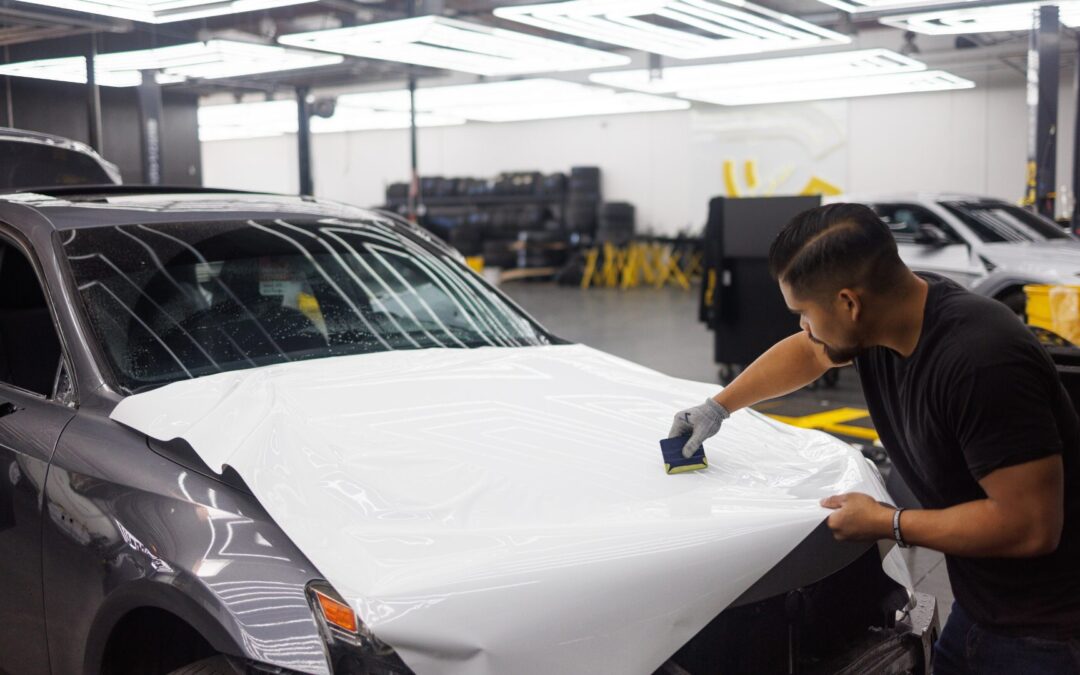Vehicle wraps are a powerful marketing tool, transforming your car, truck, or van into a mobile billboard that can capture thousands of impressions daily. However, maintaining a vehicle wrap’s quality and appearance in extreme weather conditions can be challenging. Whether dealing with scorching summer heat, icy winter conditions, or heavy rains, taking extra care of your vehicle wrap can ensure it remains vibrant and damage-free. In this blog, we’ll discuss effective ways to care for and maintain your vehicle wrap in various climates, so it lasts longer and keeps looking sharp.
The Impact of Weather on Vehicle Wraps
Vehicle wraps are made from vinyl, a durable material that can withstand a lot. However, like any other material, vinyl has its limitations. Extreme temperatures, UV rays, moisture, and road salt can all take a toll on the appearance and durability of your wrap if it isn’t properly maintained. Here are the effects of each type of weather condition on vinyl wraps:
- High Heat and UV Exposure: Prolonged exposure to direct sunlight and high temperatures can cause the vinyl to fade, crack, or bubble. UV rays are particularly harsh on colors, causing them to fade over time.
- Snow, Ice, and Road Salt: Winter conditions introduce snow, ice, and road salt, all of which can degrade vinyl wraps. Road salt is particularly corrosive, and if it isn’t washed off regularly, it can lead to peeling and damage to the adhesive layer.
- Rain and High Humidity: Excessive rain and high humidity can lead to water damage, particularly at the seams and edges of the wrap. Water can seep under the wrap, causing bubbling, peeling, or mold growth.
Understanding how each of these elements impacts vehicle wraps is the first step in protecting your investment. Now, let’s dive into specific maintenance tips for each type of extreme weather condition.
Caring for Vehicle Wraps in Hot Summer Conditions
Summer heat and sun exposure can be particularly damaging to vinyl wraps. Here’s how to keep your wrap looking vibrant and well-maintained during the hot summer months:
1. Park in the Shade or Use a Car Cover
When possible, park your vehicle in the shade or use a car cover to protect the wrap from direct sunlight. Continuous exposure to UV rays will fade colors and weaken the wrap’s material. If a covered area isn’t available, a high-quality car cover can help protect the wrap from the harsh sun.
2. Regular Washing to Remove Dust and Dirt
Dust and dirt can accumulate on the surface of the wrap, dulling its shine. In hot weather, this layer of grime can bake onto the vinyl, making it harder to clean. Regularly washing your vehicle with a mild soap and water solution can help remove this buildup and maintain the wrap’s appearance.
- Tip: Avoid using abrasive sponges or brushes, as they can scratch the vinyl. Use a soft microfiber cloth instead.
3. Use a UV Protectant
UV protectants specifically designed for vinyl wraps can add an extra layer of defense against the sun’s rays. Look for a protectant that’s safe for vinyl and apply it according to the manufacturer’s instructions. This protective layer helps prevent fading and cracking and keeps your wrap looking fresh.
4. Avoid High-Pressure Washes
High-pressure water can lift the edges of the vinyl wrap, especially in hot weather when the adhesive can soften. Instead, opt for a gentle hand wash, or if you must use a pressure washer, keep it at a lower pressure and maintain a safe distance.
5. Check for Signs of Heat Damage
Regularly inspect your wrap for signs of heat damage, such as bubbling, fading, or peeling at the edges. Address any issues early, as small damages can worsen if left unattended. If you notice any significant fading or cracking, it may be time to consider a professional touch-up.
Protecting Vehicle Wraps in Snowy Winters
Winter brings its own set of challenges for vehicle wraps, including freezing temperatures, road salt, and icy conditions. Here are some tips to maintain your wrap during the winter season:
1. Rinse Off Road Salt Regularly
Road salt is notorious for causing corrosion, and it can be especially damaging to vehicle wraps. Rinse off your vehicle regularly to prevent salt buildup, focusing on the lower parts of the vehicle where salt tends to accumulate. This simple step can significantly extend the life of your wrap during winter.
2. Avoid Scraping the Wrap with Hard Objects
When clearing snow and ice from your vehicle, avoid using hard scrapers or rough tools that could scratch or tear the vinyl. Instead, use a soft snow brush to gently remove snow from the vehicle without damaging the wrap.
- Tip: Never pour hot water on the wrap to melt ice, as the sudden temperature change can damage the vinyl.
3. Hand Wash Instead of Using Automatic Car Washes
Automatic car washes often use harsh chemicals and abrasive brushes that can damage the vinyl wrap, especially during winter when wraps are already under stress from cold temperatures. Opt for a gentle hand wash to keep the wrap clean without risking damage.
4. Use a Ceramic Coating
Ceramic coatings provide an extra layer of protection against road salt, moisture, and other winter elements. These coatings can help protect the vinyl from road grime and make it easier to clean. Be sure to choose a ceramic coating specifically designed for vinyl wraps and follow the application instructions carefully.
5. Inspect for Peeling or Lifting Edges
Cold weather can cause the adhesive on vinyl wraps to lose some of its grip, especially around the edges. Regularly inspect the wrap for any signs of lifting or peeling, and address any issues quickly. Catching these problems early can prevent more extensive damage later.
Maintaining Vehicle Wraps During Rainy and Humid Seasons
Heavy rainfall and high humidity can cause moisture to seep under the vinyl, leading to bubbling and peeling. Here are some ways to keep your wrap in top shape during rainy seasons:
1. Dry the Vehicle Thoroughly After Washing or Rain
If your vehicle is frequently exposed to rain, make sure to dry it thoroughly after washing or heavy rain. Use a microfiber cloth to remove excess moisture, focusing on the edges and seams where water is more likely to accumulate. This step helps prevent water from seeping under the vinyl and causing bubbles.
2. Use a Vinyl Sealant
Vinyl sealants are designed to create a waterproof barrier on the surface of the wrap, preventing water from penetrating the vinyl. Applying a sealant before the rainy season begins can add an extra layer of protection against moisture and humidity.
3. Check for Mold or Mildew Growth
In areas with high humidity, mold or mildew can sometimes develop under the vinyl, especially if water has seeped in. Regularly inspect the wrap for any signs of mold, mildew, or discoloration, and address these issues promptly to prevent further damage.
4. Store the Vehicle Indoors if Possible
If you know that a heavy rainstorm is coming, try to park your vehicle in a garage or covered area to protect the wrap from prolonged exposure to moisture. While vinyl wraps are water-resistant, constant exposure to heavy rain can lead to wear over time.
5. Avoid Parking in High-Humidity Areas
During particularly humid seasons, avoid parking in areas where moisture is likely to accumulate, such as near ponds, lakes, or heavily vegetated areas. Minimizing exposure to high humidity can help reduce the risk of moisture-related damage.
General Maintenance Tips for All Climates
Regardless of the season or weather conditions, there are a few general maintenance tips that apply to all vehicle wraps:
- Regularly Inspect the Wrap: Make a habit of inspecting your wrap every month to catch any minor issues before they become major problems. Look for signs of peeling, bubbling, fading, or cracking.
- Wash the Vehicle by Hand: Hand washing is gentler on the vinyl and reduces the risk of damage. Avoid harsh chemicals and use mild soap with a soft microfiber cloth.
- Avoid Wax or Polish: Most waxes and polishes are not compatible with vinyl wraps and can cause discoloration or damage. Stick to products designed specifically for vinyl.
- Consider Professional Maintenance: If you notice any significant wear or damage, it may be time to have a professional inspect the wrap. They can assess any issues and provide solutions, such as spot repairs or reapplication.
Conclusion
Caring for a vehicle wrap in extreme weather conditions doesn’t have to be complicated, but it does require attention to detail and consistency. Whether it’s summer, winter, or rainy season, following these tips can help keep your vehicle wrap looking fresh, vibrant, and professional for years to come. At TNT Signs, we specialize in high-quality wraps that are built to withstand the elements, but a little extra maintenance can make all the difference in extending their lifespan.
With these tips in mind, you can ensure that your vehicle wrap continues to make a strong impression, rain or shine. Contact us today to learn more about our durable wraps and how we can help you maintain them for maximum impact!









